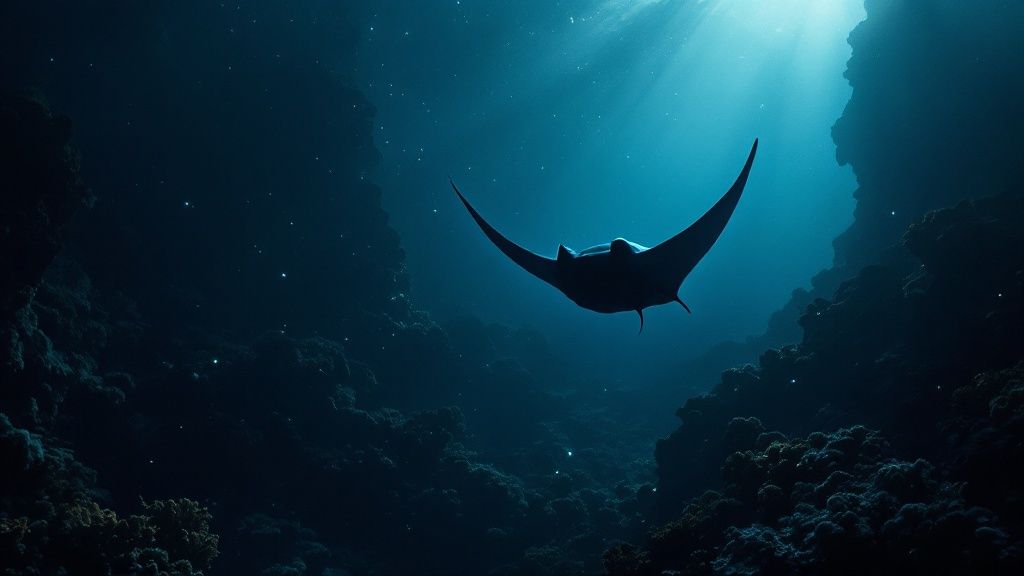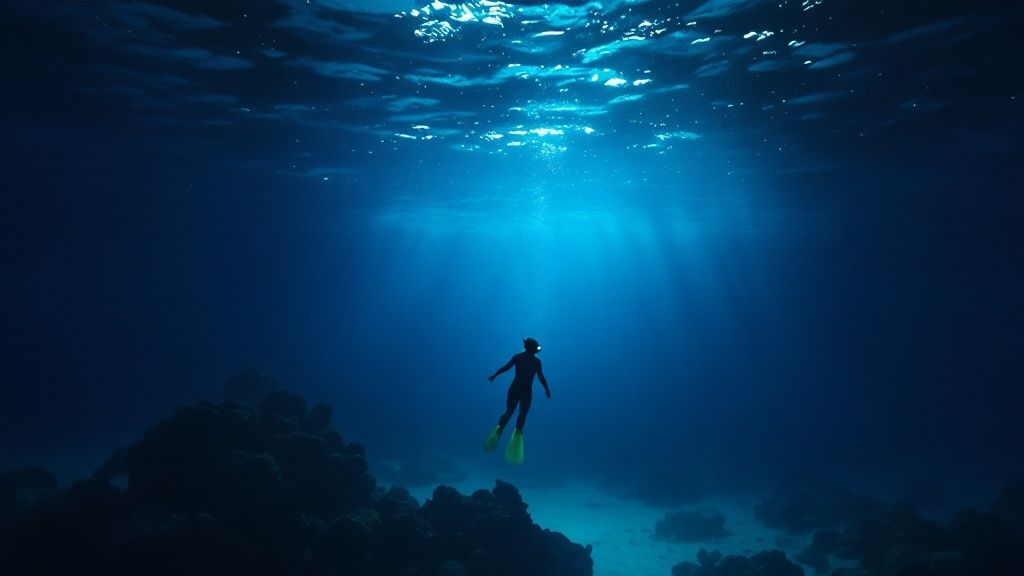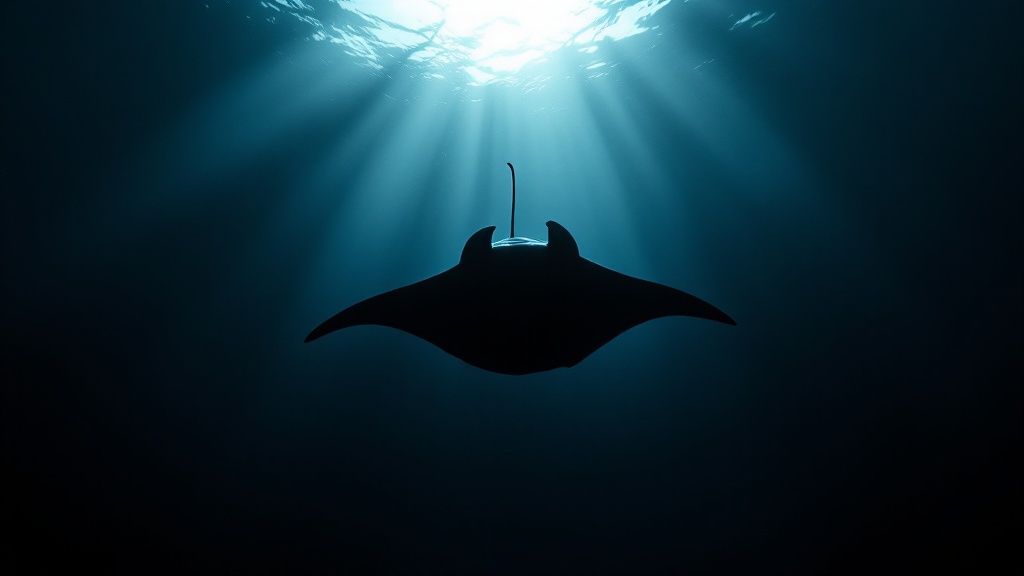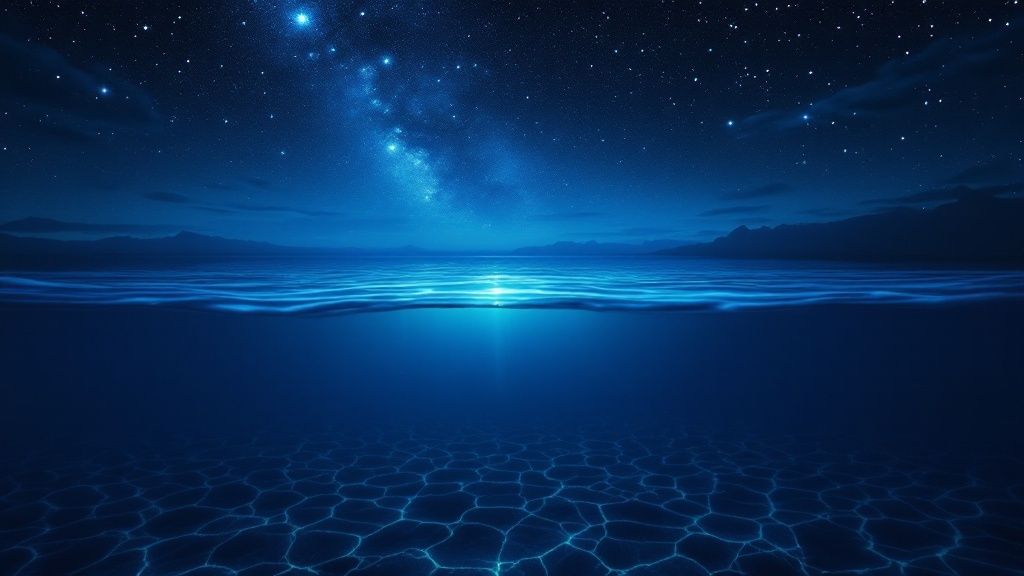Manta Ray Night Snorkel Big Island: Epic Encounter
- Byron
- Mar 11
- 14 min read
The Magic of Manta Ray Night Snorkel Big Island
The Big Island of Hawaii offers a captivating experience: the manta ray night snorkel. Thousands of visitors come every year, drawn by the chance to see these gentle giants up close. Unlike daytime snorkeling, a night snorkel offers a completely different perspective on these magnificent creatures. It’s a chance to witness an incredible display of light and shadow under the waves.

Why Nighttime Transforms the Experience
Night snorkeling with manta rays is a world away from daytime encounters. After the sun goes down, the ocean takes on a mystical feel, and the manta rays become the stars. Special underwater lights attract plankton, their main food source. This creates a feeding frenzy, bringing the mantas close to the surface. Snorkelers then have an amazing view of their graceful movements. Imagine floating as these enormous, yet elegant creatures glide below, their white undersides lit up by the lights.
The Big Island: A Perfect Manta Ray Habitat
The Big Island's volcanic topography is key to the success of manta ray night snorkeling. The underwater slopes create ideal feeding grounds, concentrating plankton and drawing mantas in reliably, night after night. This makes the Big Island a prime location for these unique encounters. The innovative light techniques used here have also changed how people interact with manta rays around the world, benefiting both tourism and research. The Big Island's Manta Ray Night Snorkel is especially popular in Keauhou Bay and the Kona Coast. The best time to go is during the summer months, from May to September, when the water is calm and clear, and manta ray activity is at its peak. Even with unpredictable weather sometimes affecting visibility, the opportunity to swim with these gentle giants is always a draw. Explore this topic further.
Accessibility for All
One of the best things about manta ray night snorkeling is how accessible it is. While basic swimming skills are recommended, people of all abilities can enjoy it. Many tour operators offer flotation devices, so even less confident swimmers can relax and watch the manta rays comfortably. This makes it a great activity for families, couples, or solo travelers.
A Truly Unforgettable Experience
From the moment you enter the water, the manta ray night snorkel is an immersive experience. The gentle ocean swells, the lights cutting through the dark water, and the sheer size and grace of the mantas create a magical feeling. It’s often a deeply moving encounter, creating a real connection with the ocean. This powerful mix of adventure, education, and natural wonder makes the Big Island manta ray night snorkel an unforgettable experience.
Prime Locations for Manta Ray Encounters
The Big Island of Hawai'i is famous for its incredible manta ray night snorkeling. People travel from all over the world to see these gentle giants up close in their natural environment. The island's unique underwater topography creates the perfect feeding grounds, drawing the manta rays in and making for an unforgettable experience.
Manta Village: A Calm and Shallow Delight
Manta Village, located in Keauhou Bay, is one of the most popular spots. Its shallow, sandy bottom makes it perfect for observing the manta rays as they perform their mesmerizing feeding dances. The bay's calm waters are ideal for snorkelers of all skill levels, from beginners to experienced divers. The shallow depth means clear views, and the gentle currents make for a relaxed snorkeling experience.
Manta Heaven: A Deeper Dive into the Blue
Another popular spot is Manta Heaven, off the Kona Coast. Living up to its name, this site often delivers breathtaking encounters with multiple manta rays. The deeper waters attract a wider variety of marine life, creating a truly spectacular underwater scene. You might even catch glimpses of other nocturnal creatures, adding an extra layer of excitement to your adventure.
Why These Locations Are Manta Ray Hotspots
The popularity of Manta Village and Manta Heaven isn't by chance. These areas have become manta ray havens thanks to a combination of factors. The ocean floor topography and abundance of plankton play a key role. Manta Village’s shallow, sandy bottom is the ideal environment for plankton to thrive, attracting large numbers of manta rays. Manta Heaven's deeper waters also offer a rich food supply, supporting a diverse and vibrant ecosystem.

To help you choose the best spot for your manta ray adventure, we've put together a comparison table:
To help you choose the right location for your adventure, take a look at this comparison:
Manta Ray Viewing Locations Comparison |
|---|
Location |
--- |
Manta Village |
Manta Heaven |
As you can see, both locations offer a high probability of seeing manta rays. Manta Village offers an easier entry point for families and those new to snorkeling, while Manta Heaven provides a richer experience for those comfortable in deeper water.
Choosing the Right Spot for Your Adventure
Both Manta Village and Manta Heaven offer exceptional opportunities to witness these magnificent creatures. The best location for you depends on your experience level and what you hope to see. Manta Village, with its calmer and shallower waters, is a great choice for families and beginners. If you're a more experienced snorkeler looking for the thrill of deeper water and potentially larger groups of manta rays, Manta Heaven might be the better option. Photographers will also appreciate the varied depths and lighting conditions at Manta Heaven.
Your Night in the Water: What to Actually Expect
So, you're ready for a magical manta ray night snorkel on the Big Island? Let's break down what awaits you, from arriving at the dock to stepping back onto dry land. Knowing what to expect will help you prepare and fully savor this incredible experience.
From Shore to Sea: Embarking on Your Adventure
A typical manta ray night snorkel tour starts with check-in and a safety briefing. This is essential for your safety and the well-being of the manta rays. Guides will cover snorkeling techniques, proper manta ray etiquette (like never touching them), and how to handle different situations. You'll likely receive a wetsuit or flotation device, especially if you're not a confident swimmer. Many tour operators also provide snorkel gear, but you're welcome to bring your own for a better fit.
Next up is the boat transfer. Most manta ray viewing spots are a short ride offshore. The boat trip itself is a scenic treat, offering coastal views as the sun dips below the horizon. During this time, guides often share insights about manta rays, their behavior, and the local ecosystem. You might learn about the different types of manta rays in Hawaiian waters, like the reef manta ray (with a wingspan up to 14 feet) and the giant oceanic manta ray.
You might be interested in: How to master...
Entering the Water: A Magical Moment
Once you reach the snorkel site, your guides will help you into the water. This is where the true adventure begins. Special underwater lights, placed on the ocean floor or attached to rafts, attract plankton. And where there's plankton, there are manta rays! The scene is truly mesmerizing as darkness surrounds you and the underwater lights create an ethereal glow.

The Manta Ray Ballet: An Unforgettable Sight
Prepare to be amazed when the manta rays arrive. These gentle giants glide effortlessly through the illuminated water, performing their captivating "manta ray ballet." They loop and swirl, often coming incredibly close to the surface and the snorkelers. Seeing these creatures, sometimes with wingspans exceeding 10 feet, move with such grace and power is breathtaking. The entire sensory experience is unforgettable: the gentle ocean swell, the beams of light piercing the darkness, and the whoosh of water as a manta ray passes inches from your mask.
Water Conditions and Visibility
Water temperature and visibility change with the seasons. Summers typically have warmer water and clearer visibility, while winters can bring cooler temperatures and potentially rougher seas. Manta ray tours operate year-round, but checking the forecast and being prepared for possible changes is always wise. No matter the season, guides expertly position snorkelers for optimal viewing while ensuring the manta rays' safety and comfort. Knowing the water conditions can also help you choose the right wetsuit thickness or decide if you'd prefer a flotation device.
Returning to Shore: Reflecting on the Experience
After about 20-30 minutes in the water, it's time to head back to the boat. The guides will retrieve the lighting equipment, and you'll climb back aboard, often with the crew's assistance. The return trip is a perfect time to warm up, share stories with fellow snorkelers, and reflect on the amazing experience. Back on shore, you'll likely have a chance to ask your guides questions or share photos and videos. The memories of your manta ray night snorkel will undoubtedly stay with you forever.
Inside the World of Magnificent Manta Rays

Manta rays are far more than just graceful giants gliding through the ocean depths. They are incredibly intelligent creatures, exhibiting complex social behaviors and fascinating biology. A deeper dive into their world reveals the true wonder of these charismatic filter feeders. This understanding transforms a simple manta ray night snorkel on the Big Island from a sighting into a truly meaningful encounter.
The Biology of Filter Feeding
Manta rays have developed a truly unique feeding strategy. Their massive mouths, combined with specialized cephalic fins, work together to funnel water and plankton towards their mouths, allowing them to efficiently consume vast quantities of these tiny organisms. While their movement may appear effortless, the actual feeding process involves a complex series of maneuvers and coordination. This intricate dance is a remarkable spectacle to observe during a night snorkel.
Social Beings: More Than Meets the Eye
Manta rays are not solitary creatures. They display complex social behaviors, often gathering in large groups known as aggregations or “fevers.” These gatherings can involve dozens of individuals engaging in a variety of activities. From feeding and cleaning to even courtship rituals, these social interactions add another layer of fascination to observing them in their natural habitat. This also highlights the importance of responsible tourism to minimize disruption to their natural interactions.
Intelligence and Longevity: An Ocean Enigma
These gentle giants possess remarkable intelligence and surprisingly long lifespans. Their large brain-to-body ratio is among the highest in fish, suggesting significant cognitive abilities. Manta rays have been observed to live for at least 40 years, with some estimates suggesting a lifespan of up to 50 years. Even more impressively, their intelligence is further highlighted by demonstrated self-awareness in mirror tests—a cognitive feat achieved by only a few animal species. This combination of intelligence, longevity, and complex social behavior makes them one of the ocean's most captivating inhabitants. Discover more insights about manta rays here.
Reef Mantas vs. Oceanic Mantas: Subtle Differences
While both reef mantas and giant oceanic mantas can be encountered during a manta ray night snorkel on the Big Island, subtle differences exist between these two species. Reef mantas are generally smaller, with wingspans reaching up to 14 feet, while giant oceanic mantas can boast wingspans exceeding 20 feet. Their color patterns and markings also vary, with reef mantas displaying more distinct and individual patterns on their ventral (belly) sides. Recognizing these differences enriches your observations and allows you to appreciate the specific characteristics of each species.
Reproduction and Communication: Unraveling the Mysteries
Manta ray reproduction is a complex and slow process. They give birth to live young, typically one pup at a time, after a gestation period of approximately one year. This slow reproductive rate makes them especially vulnerable to population decline from threats such as fishing and habitat loss. Scientists are still unraveling the mysteries of their communication methods, investigating the role of vocalizations, body language, and possibly even electrical signals.
Citizen Science: Contributing to Conservation
You can actively contribute to manta ray conservation through participating in citizen science initiatives. Many organizations collect data on manta ray sightings, utilizing the unique spot patterns on their bellies to identify and track individuals. By submitting photos and information from your Big Island manta ray night snorkel adventure, you contribute valuable data to ongoing research and monitoring efforts. This participatory approach empowers individuals to directly support conservation and become active stewards of these magnificent creatures, adding another layer of meaning to your manta ray encounter.
Selecting Your Perfect Manta Ray Experience
So, you're dreaming of a magical manta ray night snorkel on the Big Island? Fantastic! But with so many tour operators, finding the perfect fit can be tricky. This guide will give you the insights you need to choose a tour that truly shines.
Decoding Marketing Claims: Asking the Right Questions
Don't just be swayed by pretty pictures. Smart travelers know that a fantastic manta ray experience depends on more than just marketing. Before booking, ask about group size, guide experience, and the operator's environmental practices. Smaller groups often mean a more personal experience and less disruption for the manta rays. Experienced guides understand manta ray behavior, know the best viewing spots, and prioritize safety.
Boat Design and Group Size: Impacting Your Encounter
The boat itself plays a big role in your experience. Look for operators with boats designed for easy water entry and exit, especially if you have mobility concerns. Large, crowded boats can make getting in and out of the water chaotic, taking away from the overall experience. How the tour operator manages the group in the water is also key. Good guides make sure snorkelers are spread out, minimizing disturbance to the mantas and maximizing individual viewing time.
Recognizing Responsible Operators: Prioritizing Manta Well-being
Choosing an environmentally responsible operator is essential. Look for companies dedicated to sustainable practices, like using reef-safe sunscreen and minimizing their environmental impact. An estimated 80,000 people snorkel and dive with manta rays each year in Hawaii, making responsible tourism vital for their well-being. The Kona Coast, a hotspot for these activities, benefits from resorts like the Outrigger Kona Resort & Spa, which offer nightly tours focused on conservation. For more on manta ray tourism, check out this link: Learn more about Manta Ray Tourism. You can also explore our sitemap for further reading.
Transparent Pricing and Red Flags: Setting Realistic Expectations
Be cautious of unusually low prices, which could signal compromises on safety or quality. Reputable operators are upfront about what's included, like equipment rental, wetsuits, and guide services. Red flags include skipped safety briefings, overcrowded boats, or guides who allow touching or harassing the manta rays.
Specialized Advice: Catering to Diverse Needs
Every traveler is different. Families with young children should seek out operators experienced with kids and offering suitable flotation devices. Photographers should ask about camera policies and lighting conditions. Those with mobility issues need to ensure easy access to and from the water.
To help you compare different tour operators, we've compiled the following table:
Manta Ray Tour Operator Comparison
Detailed comparison of leading manta ray night snorkel tour operators on the Big Island to help visitors select the best option
Tour Operator | Group Size | Price Range | Equipment Provided | Educational Component | Sustainability Practices |
|---|---|---|---|---|---|
Information will be populated here based on real tour operators once they are specified. | |||||
This table will be populated with real data once specific tour operators are identified for comparison. Key factors to consider are group size, included equipment, and the operator's commitment to sustainable practices.
Making Informed Decisions: Ensuring a Magical Experience
Choosing the right manta ray night snorkel tour takes research and asking smart questions. By considering factors like boat design, group size management, guide expertise, environmental practices, and price transparency, you can choose an experience that will surpass your expectations. This thoughtful planning will elevate your adventure from simply seeing manta rays to truly connecting with these gentle giants and experiencing the magic of this unique Big Island encounter.
Insider Tips for an Extraordinary Manta Encounter
Transform your manta ray night snorkel on the Big Island from memorable to truly mind-blowing. These insider tips, gathered from photographers, marine biologists, and experienced guides, will enhance your encounter while respecting these gentle giants.
Mastering the Art of Body Positioning
Subtle shifts in your body position can dramatically improve your chances of a close encounter. Imagine the manta rays as graceful dancers performing a ballet. You want a front-row seat, but not so close that you disrupt the performance. Remain calm and still, allowing the mantas to approach you.
Avoid sudden movements or splashing, which can frighten them. Instead, try floating horizontally with your fins submerged. This minimizes disturbance and allows the manta rays to feel comfortable approaching, offering incredible close-up views.
Tackling Common Challenges
Even experienced snorkelers can face challenges during a night snorkel. Mask fogging is a common issue. Try using baby shampoo or a specialized defogger before entering the water.
For seasickness, consider taking motion sickness medication or using acupressure wristbands before the boat trip. Orientation in low light can be improved by focusing on the underwater lights. These lights act like beacons, attracting both plankton and the manta rays.
Photography Prowess: Capturing the Magic
For stunning photos, consider these pro-level techniques. Adjust your camera settings for low light, increasing ISO and using a wide aperture. Position yourself strategically, anticipating the manta rays’ movements.
Remember, flash photography is discouraged as it can startle the mantas. Learn more in this article about Manta Ray Photography Tips. Prioritize the manta rays’ well-being over the perfect shot. Avoid chasing them or blocking their path.
Mindfulness in the Water: Transforming Anxiety into Presence
For those new to snorkeling or feeling nervous, mindfulness can transform anxiety into wonder. Before entering the water, take a few deep breaths, focusing on the present moment. Visualize yourself floating calmly amongst the manta rays.
Remember, the guides are there to support you. This mindful approach will enhance your ability to appreciate the magical experience.
Practical Preparations: Packing, Pre-Trip, and Post-Snorkel
Proper preparation enhances your experience. Pack a small waterproof bag for essentials like sunscreen and a towel. Review the tour operator's information and arrive on time.
After your snorkel, take time to reflect. Journaling or sharing stories can help solidify these memories.
Pre-Trip Checklist: Ensuring a Smooth Adventure
Consult your doctor about seasickness medication if needed. Communicate any dietary restrictions to the tour operator. Review basic snorkeling techniques and practice in a pool if you haven't snorkeled recently.
Finally, check the weather forecast and be prepared for possible changes, as manta ray tours are weather-dependent.
Post-Snorkel Reflections: Cementing the Magic
After your snorkel, reflect on the experience. Consider journaling about your observations. Look back at your photos or videos, reliving the wonder of the encounters.
Sharing your experiences with others can amplify the joy and inspire appreciation for these creatures. Researching more about manta rays and their conservation can deepen your connection to the experience.
Crafting Your Ultimate Big Island Manta Adventure
Your manta ray night snorkel is more than just a single activity; it's a highlight of your Big Island trip. To truly maximize this experience, consider how it fits within your overall itinerary. Strategic planning, factoring in elements like the moon phase, seasonal conditions, and complementary activities, can elevate your manta ray experience.
Timing Is Everything: Moon Phases and Seasonal Considerations
The moon's brightness can affect plankton visibility, influencing manta ray activity. A new moon or a crescent moon often provides the darkest skies, making underwater lights even more attractive to plankton, and consequently, the mantas. Summer (May to September) generally offers calmer waters and better visibility, ideal for snorkeling. However, mantas are present year-round, each season offering a unique experience.
Location, Location, Location: Accommodations Near Departure Points
Choose accommodations strategically located near manta ray tour departure points like Keauhou Bay or Kona. Luxury resorts with direct beach access offer convenience and pampering. Budget-friendly hotels and condos near transportation hubs provide more affordable options. Some resorts, like the Outrigger Kona Resort & Spa, even offer manta ray tours directly. Consider your travel style and budget when selecting your accommodations.
Day and Night Synergies: Complementary Activities
Create a cohesive marine exploration theme by incorporating daytime activities that complement your night snorkel.
Explore tide pools teeming with colorful marine life.
Visit the Mokupapapa Discovery Center in Hilo to learn about the remote Northwestern Hawaiian Islands.
Consider a whale watching tour (seasonal).
These activities pair perfectly with your manta ray adventure.
Contingency Planning: Weather and Transportation Logistics
The Big Island's weather can be unpredictable, so contingency planning is key. Have backup activities if your manta ray tour is canceled due to weather. The island's diverse microclimates offer alternatives. If Kona is rainy, the Kohala Coast might be sunny. This flexibility helps your vacation run smoothly, rain or shine.
Confirm transportation well in advance. Whether you're renting a car, using ride-sharing services, or relying on public transportation, a solid plan prevents last-minute stress. Research your location’s accessibility and plan your route to the departure point.
Crafting Your Itinerary: Example Scenarios
Here are sample itineraries incorporating a manta ray night snorkel:
Option 1: Relaxation and Marine Life: Relax on the beach, explore tide pools, and visit Puʻuhonua o Hōnaunau National Historical Park during the day. Enjoy your manta ray adventure in the evening.
Option 2: Adventure and Exploration: Hike to a remote black sand beach, kayak, stand-up paddleboard, or explore volcanic landscapes. Conclude your day with a magical manta ray night snorkel.
Option 3: Culture and Marine Life: Immerse yourself in Hawaiian culture at a luau, visit historical sites, and browse local markets. As night falls, experience the wonder of the manta rays.
Thoughtful planning ensures a seamless and unforgettable Big Island experience, with your manta ray night snorkel as a highlight. Book your manta ray night snorkel experience with Manta Ray Night Snorkel Kona Hawaii Tours! Click here to book your tour.
Comments